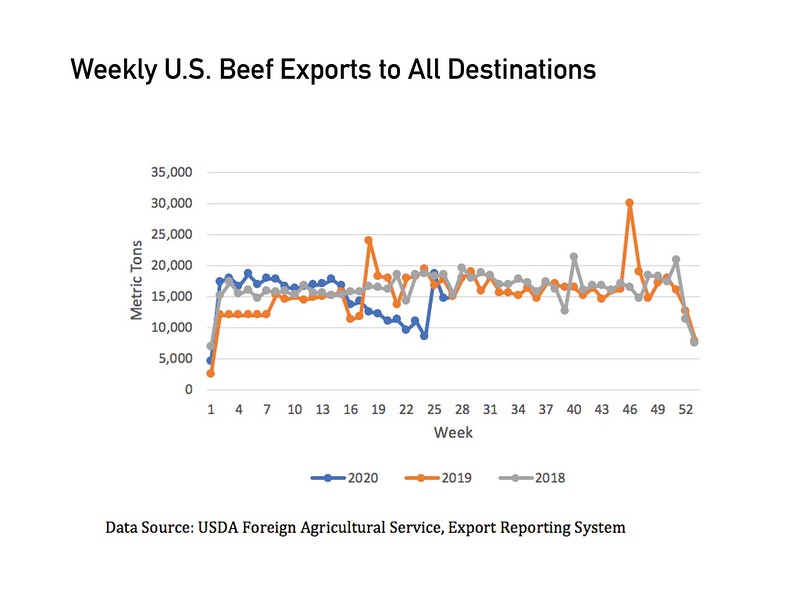July 17, 2020
Pork, chicken exports holding up despite COVID interruptions
By Mary Hightower
U of A System Division of Agriculture
Fast facts
- Strong demand in China for pork, chicken
- COVID has higher impacts on beef production, echoed in exports
(394 words)
(Newsrooms: With additional graphs at https://flic.kr/s/aHsmPrX5K6)
FAYETTEVILLE, Ark. — The impact of COVID-19 on meat exports has leaned more heavily on beef than chicken or pork, according to an economic analysis the University of Arkansas System Division of Agriculture released this week.
“Exports represent a significant component of meat demand,” said John Anderson, head of the agricultural economics and agribusiness department for the Division of Agriculture and the Dale Bumpers College of Agricultural, Food and Life Sciences.
“Last year, 22.9 percent of pork, 16.4 percent of chicken and 11.1 percent of beef production in the United States was exported,” he said. “So far, the impact of COVID-19 on exports has been remarkably small for pork and chicken, considerably more significant for beef.”
Pork has been riding high primarily due to strong growth in exports to China, whose own production has been hamstrung by African Swine Fever.
According to estimates from the U.S. Department of Agriculture, “domestic pork production in China in 2020 will amount to about 36 million metric tons. This is down from over 54 million metric tons just two years ago and will be, if realized, the smallest domestic pork production in China since about 1997,” Anderson said. “In short, the reduction in pork production in China has, so far, outweighed any negative effects on pork demand such that U.S. pork exports to China remain quite strong, year-over-year.”
Beef exports have fallen considerably as a result of COVID-19, he said.
“This is not likely primarily due to demand effects but rather to the supply constraints that occurred over the last couple of months as a result of COVID-related packing plant disruptions,” Anderson said. However, “in the most recent three weeks, though, beef exports have largely recovered and are back to about even with the last couple of years.”
Poultry exports have had their ups and downs since the pandemic declaration, but chicken has remained relatively consistent. China has been a strong market for American poultry.
“In May, China accounted for more than 14 percent of all foreign sales – the largest share of U.S. chicken exports for that country since 2009,” Anderson said. “In short, chicken exports probably have suffered some from COVID-19 disruptions, but with strong fundamentals in China, exports have held up well in recent historical context.
Monday’s report is part of the department’s weekly analyses of the impact of COVID-19 on the economy.
To learn about extension and research programs in Arkansas, visit uada.edu, Follow us on Twitter at @AgInArk, @uaex_edu or @ArkAgResearch.
About the Division of Agriculture
The University of Arkansas System Division of Agriculture’s mission is to strengthen agriculture, communities, and families by connecting trusted research to the adoption of best practices. Through the Agricultural Experiment Station and the Cooperative Extension Service, the Division of Agriculture conducts research and extension work within the nation’s historic land grant education system.
The Division of Agriculture is one of 20 entities within the University of Arkansas System. It has offices in all 75 counties in Arkansas and faculty on five system campuses.
Pursuant to 7 CFR § 15.3, the University of Arkansas System Division of Agriculture offers all its Extension and Research programs and services (including employment) without regard to race, color, sex, national origin, religion, age, disability, marital or veteran status, genetic information, sexual preference, pregnancy or any other legally protected status, and is an equal opportunity institution.
# # #
Media Contact: Mary Hightower
Chief Communications Officer
University of Arkansas System Division of Agriculture
mhightower@uada.edu
501-671-2006
